UTS MPO 21129: Critically Evaluating Culture and Leadership Essay
VerifiedAdded on 2023/03/29
|13
|2851
|368
Essay
AI Summary
This essay critically evaluates the concepts of culture within organizations, drawing upon various theoretical perspectives and real-world examples. It discusses the role of leaders and managers in shaping organizational culture, the impact of globalization on cultural convergence, and the importance of cultural sensitivity in cross-cultural interactions. The essay explores the complexities of national and organizational cultures, examining the limitations of convergence theories and the need for a nuanced understanding of cultural dynamics in a globalized business environment. It references key works by scholars such as Brewis, Fredrickson, Kärreman, Alvesson, Ogbonna, Wilkinson, and Schein to provide a comprehensive analysis of culture management and its implications for organizational success.
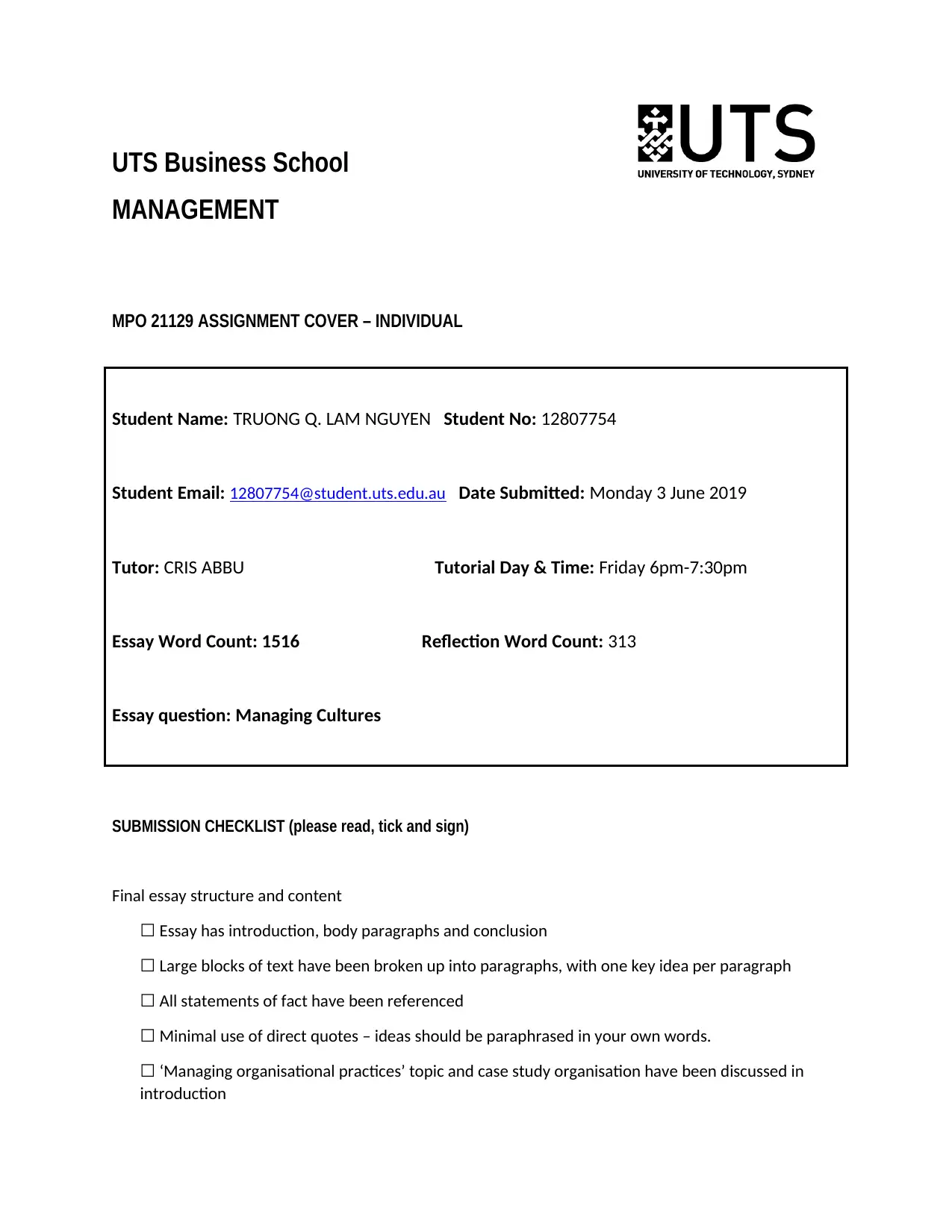
UTS Business School
MANAGEMENT
MPO 21129 ASSIGNMENT COVER – INDIVIDUAL
Student Name: TRUONG Q. LAM NGUYEN Student No: 12807754
Student Email: 12807754@student.uts.edu.au Date Submitted: Monday 3 June 2019
Tutor: CRIS ABBU Tutorial Day & Time: Friday 6pm-7:30pm
Essay Word Count: 1516 Reflection Word Count: 313
Essay question: Managing Cultures
SUBMISSION CHECKLIST (please read, tick and sign)
Final essay structure and content
☐ Essay has introduction, body paragraphs and conclusion
☐ Large blocks of text have been broken up into paragraphs, with one key idea per paragraph
☐ All statements of fact have been referenced
☐ Minimal use of direct quotes – ideas should be paraphrased in your own words.
☐ ‘Managing organisational practices’ topic and case study organisation have been discussed in
introduction
MANAGEMENT
MPO 21129 ASSIGNMENT COVER – INDIVIDUAL
Student Name: TRUONG Q. LAM NGUYEN Student No: 12807754
Student Email: 12807754@student.uts.edu.au Date Submitted: Monday 3 June 2019
Tutor: CRIS ABBU Tutorial Day & Time: Friday 6pm-7:30pm
Essay Word Count: 1516 Reflection Word Count: 313
Essay question: Managing Cultures
SUBMISSION CHECKLIST (please read, tick and sign)
Final essay structure and content
☐ Essay has introduction, body paragraphs and conclusion
☐ Large blocks of text have been broken up into paragraphs, with one key idea per paragraph
☐ All statements of fact have been referenced
☐ Minimal use of direct quotes – ideas should be paraphrased in your own words.
☐ ‘Managing organisational practices’ topic and case study organisation have been discussed in
introduction
Paraphrase This Document
Need a fresh take? Get an instant paraphrase of this document with our AI Paraphraser
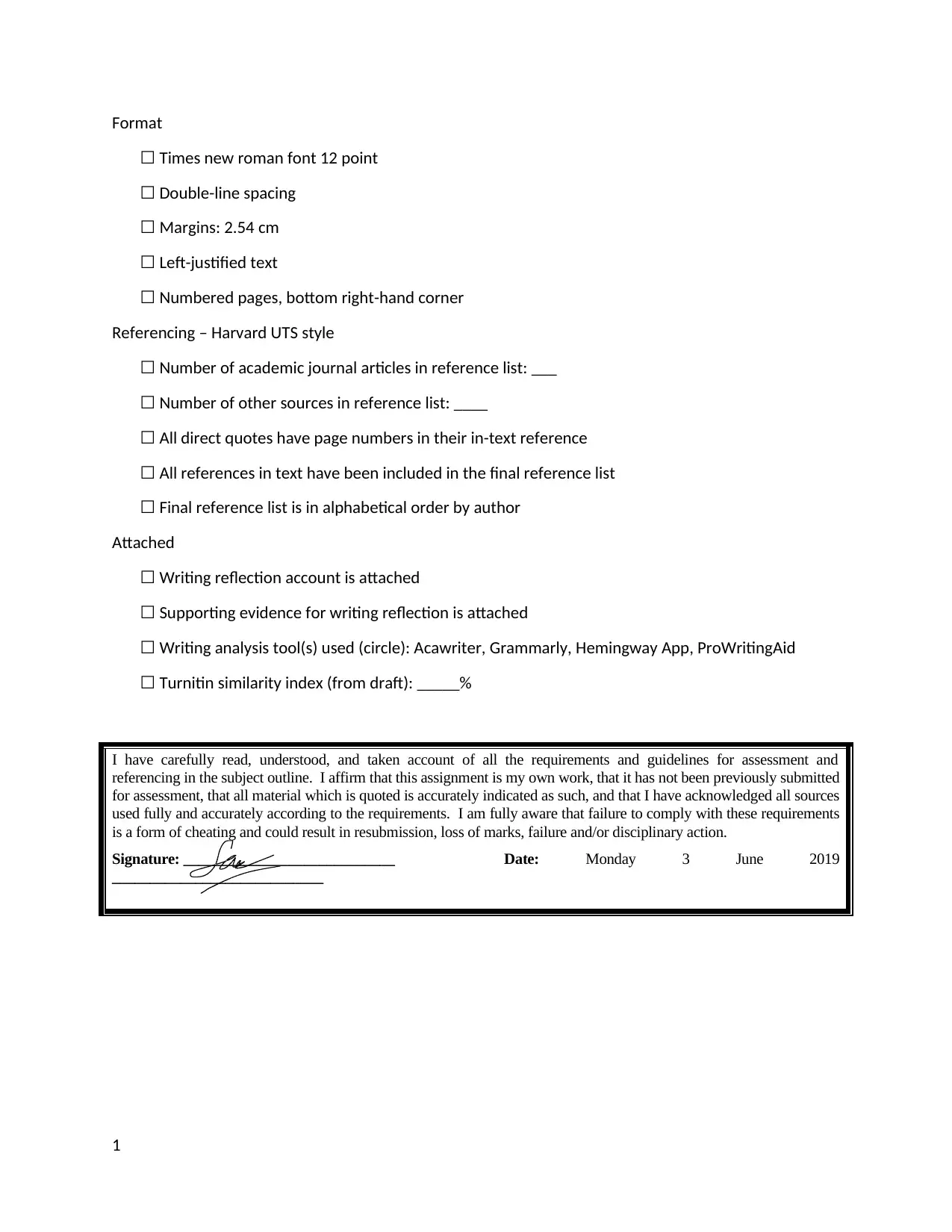
Format
☐ Times new roman font 12 point
☐ Double-line spacing
☐ Margins: 2.54 cm
☐ Left-justified text
☐ Numbered pages, bottom right-hand corner
Referencing – Harvard UTS style
☐ Number of academic journal articles in reference list: ___
☐ Number of other sources in reference list: ____
☐ All direct quotes have page numbers in their in-text reference
☐ All references in text have been included in the final reference list
☐ Final reference list is in alphabetical order by author
Attached
☐ Writing reflection account is attached
☐ Supporting evidence for writing reflection is attached
☐ Writing analysis tool(s) used (circle): Acawriter, Grammarly, Hemingway App, ProWritingAid
☐ Turnitin similarity index (from draft): _____%
I have carefully read, understood, and taken account of all the requirements and guidelines for assessment and
referencing in the subject outline. I affirm that this assignment is my own work, that it has not been previously submitted
for assessment, that all material which is quoted is accurately indicated as such, and that I have acknowledged all sources
used fully and accurately according to the requirements. I am fully aware that failure to comply with these requirements
is a form of cheating and could result in resubmission, loss of marks, failure and/or disciplinary action.
Signature: ____________________________ Date: Monday 3 June 2019
____________________________
1
☐ Times new roman font 12 point
☐ Double-line spacing
☐ Margins: 2.54 cm
☐ Left-justified text
☐ Numbered pages, bottom right-hand corner
Referencing – Harvard UTS style
☐ Number of academic journal articles in reference list: ___
☐ Number of other sources in reference list: ____
☐ All direct quotes have page numbers in their in-text reference
☐ All references in text have been included in the final reference list
☐ Final reference list is in alphabetical order by author
Attached
☐ Writing reflection account is attached
☐ Supporting evidence for writing reflection is attached
☐ Writing analysis tool(s) used (circle): Acawriter, Grammarly, Hemingway App, ProWritingAid
☐ Turnitin similarity index (from draft): _____%
I have carefully read, understood, and taken account of all the requirements and guidelines for assessment and
referencing in the subject outline. I affirm that this assignment is my own work, that it has not been previously submitted
for assessment, that all material which is quoted is accurately indicated as such, and that I have acknowledged all sources
used fully and accurately according to the requirements. I am fully aware that failure to comply with these requirements
is a form of cheating and could result in resubmission, loss of marks, failure and/or disciplinary action.
Signature: ____________________________ Date: Monday 3 June 2019
____________________________
1

Managing cultures
Organizations are today characterized by dynamic technological developments,
intensified by the existence of competition and self-enhancing values. Competitive advantage
ensures the growth of an organization to extend its market niche. Michael Porter associates the
competitive advantage on a positive view while Gary Harmel works on it with it on a resource
view. Organizations can only retain their competitive edge by changing to meet the wants of the
business environment. The strategies implemented will improve organizations learning and
knowledge. Existing cultures and prevailing organization cultures to be precise plays an
important role in ensuring success. As discussed by Brewis (2007), the need to place cultures on
a psychological platform will distinguish procedural and declarative knowledge.
The culture of an organization displays on economic performance and the company’s
continuity. For instance, an organization with a dedicated and strong team built through
visionary leaders end up with more financial successful years on a long-term basis.
Organizations structure also facilitates the success of new products and process innovation and
change. Culture management is a relevant process in the growth of an organization, and its extent
is felt on the two articles above. Brewis (2007) explains that managing organizational culture is
the ultimate goal for an organization to realize the length of its potential. Fredrickson (2003),
however, states that culture just gives direction to the staff on what they believe and how things
should be run. Business platforms require both leaders and managers. Though taken by many
individuals to mean the same, the two aspects of the business are different. A good manager and
leader offer the success of the organization at different levels.
Corporate culture is a strategic investment that ensures well-driven business activities.
The needs to create success in the economy that comes with corporate change are extensive.
2
Organizations are today characterized by dynamic technological developments,
intensified by the existence of competition and self-enhancing values. Competitive advantage
ensures the growth of an organization to extend its market niche. Michael Porter associates the
competitive advantage on a positive view while Gary Harmel works on it with it on a resource
view. Organizations can only retain their competitive edge by changing to meet the wants of the
business environment. The strategies implemented will improve organizations learning and
knowledge. Existing cultures and prevailing organization cultures to be precise plays an
important role in ensuring success. As discussed by Brewis (2007), the need to place cultures on
a psychological platform will distinguish procedural and declarative knowledge.
The culture of an organization displays on economic performance and the company’s
continuity. For instance, an organization with a dedicated and strong team built through
visionary leaders end up with more financial successful years on a long-term basis.
Organizations structure also facilitates the success of new products and process innovation and
change. Culture management is a relevant process in the growth of an organization, and its extent
is felt on the two articles above. Brewis (2007) explains that managing organizational culture is
the ultimate goal for an organization to realize the length of its potential. Fredrickson (2003),
however, states that culture just gives direction to the staff on what they believe and how things
should be run. Business platforms require both leaders and managers. Though taken by many
individuals to mean the same, the two aspects of the business are different. A good manager and
leader offer the success of the organization at different levels.
Corporate culture is a strategic investment that ensures well-driven business activities.
The needs to create success in the economy that comes with corporate change are extensive.
2
⊘ This is a preview!⊘
Do you want full access?
Subscribe today to unlock all pages.

Trusted by 1+ million students worldwide
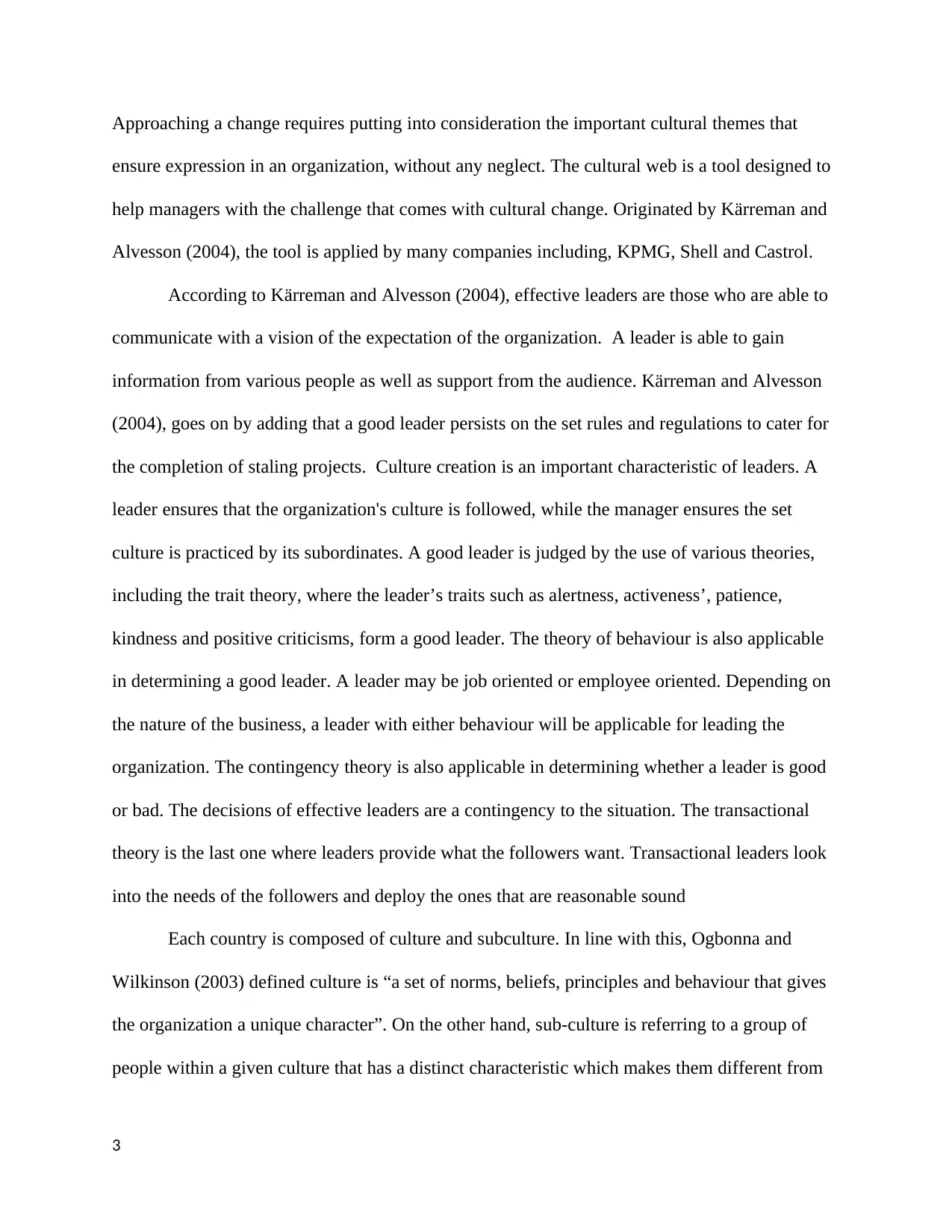
Approaching a change requires putting into consideration the important cultural themes that
ensure expression in an organization, without any neglect. The cultural web is a tool designed to
help managers with the challenge that comes with cultural change. Originated by Kärreman and
Alvesson (2004), the tool is applied by many companies including, KPMG, Shell and Castrol.
According to Kärreman and Alvesson (2004), effective leaders are those who are able to
communicate with a vision of the expectation of the organization. A leader is able to gain
information from various people as well as support from the audience. Kärreman and Alvesson
(2004), goes on by adding that a good leader persists on the set rules and regulations to cater for
the completion of staling projects. Culture creation is an important characteristic of leaders. A
leader ensures that the organization's culture is followed, while the manager ensures the set
culture is practiced by its subordinates. A good leader is judged by the use of various theories,
including the trait theory, where the leader’s traits such as alertness, activeness’, patience,
kindness and positive criticisms, form a good leader. The theory of behaviour is also applicable
in determining a good leader. A leader may be job oriented or employee oriented. Depending on
the nature of the business, a leader with either behaviour will be applicable for leading the
organization. The contingency theory is also applicable in determining whether a leader is good
or bad. The decisions of effective leaders are a contingency to the situation. The transactional
theory is the last one where leaders provide what the followers want. Transactional leaders look
into the needs of the followers and deploy the ones that are reasonable sound
Each country is composed of culture and subculture. In line with this, Ogbonna and
Wilkinson (2003) defined culture is “a set of norms, beliefs, principles and behaviour that gives
the organization a unique character”. On the other hand, sub-culture is referring to a group of
people within a given culture that has a distinct characteristic which makes them different from
3
ensure expression in an organization, without any neglect. The cultural web is a tool designed to
help managers with the challenge that comes with cultural change. Originated by Kärreman and
Alvesson (2004), the tool is applied by many companies including, KPMG, Shell and Castrol.
According to Kärreman and Alvesson (2004), effective leaders are those who are able to
communicate with a vision of the expectation of the organization. A leader is able to gain
information from various people as well as support from the audience. Kärreman and Alvesson
(2004), goes on by adding that a good leader persists on the set rules and regulations to cater for
the completion of staling projects. Culture creation is an important characteristic of leaders. A
leader ensures that the organization's culture is followed, while the manager ensures the set
culture is practiced by its subordinates. A good leader is judged by the use of various theories,
including the trait theory, where the leader’s traits such as alertness, activeness’, patience,
kindness and positive criticisms, form a good leader. The theory of behaviour is also applicable
in determining a good leader. A leader may be job oriented or employee oriented. Depending on
the nature of the business, a leader with either behaviour will be applicable for leading the
organization. The contingency theory is also applicable in determining whether a leader is good
or bad. The decisions of effective leaders are a contingency to the situation. The transactional
theory is the last one where leaders provide what the followers want. Transactional leaders look
into the needs of the followers and deploy the ones that are reasonable sound
Each country is composed of culture and subculture. In line with this, Ogbonna and
Wilkinson (2003) defined culture is “a set of norms, beliefs, principles and behaviour that gives
the organization a unique character”. On the other hand, sub-culture is referring to a group of
people within a given culture that has a distinct characteristic which makes them different from
3
Paraphrase This Document
Need a fresh take? Get an instant paraphrase of this document with our AI Paraphraser

the context of a larger culture. As a result of globalisation, the business transaction between
developed countries and developing countries has become very active. Along with the major
changes in the structure and flow of business transactions today, developed countries
continuously aim to increase their returns on investment not only by transferring the Western
management practices all over the developing countries but also in learning more about the
culture and sub-culture of other countries
In order to fully understand the aforementioned topic of discussion, one needs to identify
the characteristics of organizations and individuals in terms of universal cultural values. The
expression "universal values" is sometimes used to mean values that apply - or should apply - to
everyone, in every society and every culture (Tran 2017). In consideration of the aforementioned
point, Abraham Maslow's hierarchy of needs demonstrates divergence as opposed to
convergence, whilst concurring with many authors' views upon universals, Maslow clearly
identifies, through the five-tier theory that developing countries have certainly not progressed
through the tiers as speedily as richer countries, for example, citizens of the USA and UK, tend
to have met their needs of food, drink and social belonging and thus would not find these factors
a motivation within companies, however citizens of developing countries will work purely to
feed their families as opposed to reaching the top stage of self-actualization (Rosen 1998).
They are having looked into cultural universals; this essay shall precede to concern itself
with the convergence hypothesis. The authors offer two hypotheses regarding the contention of
converging national cultures; within both hypotheses, the essay will portray the authors'
accuracies as well as the flaws contained. "Convergence Myth One: the world is getting smaller,"
through its identification of advances in communication and transportation, for example, email
4
developed countries and developing countries has become very active. Along with the major
changes in the structure and flow of business transactions today, developed countries
continuously aim to increase their returns on investment not only by transferring the Western
management practices all over the developing countries but also in learning more about the
culture and sub-culture of other countries
In order to fully understand the aforementioned topic of discussion, one needs to identify
the characteristics of organizations and individuals in terms of universal cultural values. The
expression "universal values" is sometimes used to mean values that apply - or should apply - to
everyone, in every society and every culture (Tran 2017). In consideration of the aforementioned
point, Abraham Maslow's hierarchy of needs demonstrates divergence as opposed to
convergence, whilst concurring with many authors' views upon universals, Maslow clearly
identifies, through the five-tier theory that developing countries have certainly not progressed
through the tiers as speedily as richer countries, for example, citizens of the USA and UK, tend
to have met their needs of food, drink and social belonging and thus would not find these factors
a motivation within companies, however citizens of developing countries will work purely to
feed their families as opposed to reaching the top stage of self-actualization (Rosen 1998).
They are having looked into cultural universals; this essay shall precede to concern itself
with the convergence hypothesis. The authors offer two hypotheses regarding the contention of
converging national cultures; within both hypotheses, the essay will portray the authors'
accuracies as well as the flaws contained. "Convergence Myth One: the world is getting smaller,"
through its identification of advances in communication and transportation, for example, email
4

and telecommunications, clearly highlights organizational universal cultural values and concurs
with Marshal McLuhan's concept of a "global village." (Rosen 1998).
It is suggested however that McLuhan's "global village" is an ambiguous concept, a
notion that not only portrays interconnectedness, but also closeness and reciprocity in
relationships all of which are considered, "a very large scale idyll" Bearing in mind Hannerz
view upon McLuhan's "global village" one could point out that this notion alone is two-sided.
That is, organizations may well feel closeness and connectedness through technological and
communicational advances and emerging globalization, creating cross-cultural organizational
homogeneity, yet on the other hand, however, cross-national social groups still conflict for
example through religious differences (Aggarwal and Zhan 2017).
Within Schneider and Barsoux first hypothesis, the contention of convergence is further
highlighted through the authors' acknowledgement of what they describe as a "melting pot."
(Schein 1990). Large cities, for example, Paris, London, Toronto and Bombay, housing and
attracting individuals from all over the world, bringing together a mix of extremely diverse
cultures. However, the authors proceed to highlight the cultural fragments found in other large
cities, for example, New York, where such cultures are widely dispersed, where one finds
distinct neighbourhoods, Little Italy, Chinatown, and Germantown to name but a few. The above
angle of the author’s convergence myth clearly indicates that it is not cultural convergence we
see taking place, rather, "each race developing a competitive language and culture." (Schein
1990).
In consideration of the above points made, it is here that the mention of the Cultural
Imperialism Theory becomes relevant. Through the writings of Schein (1990), it would appear
that Schneider and Barsoux's "melting pot" actually appears to better portray Cranes
5
with Marshal McLuhan's concept of a "global village." (Rosen 1998).
It is suggested however that McLuhan's "global village" is an ambiguous concept, a
notion that not only portrays interconnectedness, but also closeness and reciprocity in
relationships all of which are considered, "a very large scale idyll" Bearing in mind Hannerz
view upon McLuhan's "global village" one could point out that this notion alone is two-sided.
That is, organizations may well feel closeness and connectedness through technological and
communicational advances and emerging globalization, creating cross-cultural organizational
homogeneity, yet on the other hand, however, cross-national social groups still conflict for
example through religious differences (Aggarwal and Zhan 2017).
Within Schneider and Barsoux first hypothesis, the contention of convergence is further
highlighted through the authors' acknowledgement of what they describe as a "melting pot."
(Schein 1990). Large cities, for example, Paris, London, Toronto and Bombay, housing and
attracting individuals from all over the world, bringing together a mix of extremely diverse
cultures. However, the authors proceed to highlight the cultural fragments found in other large
cities, for example, New York, where such cultures are widely dispersed, where one finds
distinct neighbourhoods, Little Italy, Chinatown, and Germantown to name but a few. The above
angle of the author’s convergence myth clearly indicates that it is not cultural convergence we
see taking place, rather, "each race developing a competitive language and culture." (Schein
1990).
In consideration of the above points made, it is here that the mention of the Cultural
Imperialism Theory becomes relevant. Through the writings of Schein (1990), it would appear
that Schneider and Barsoux's "melting pot" actually appears to better portray Cranes
5
⊘ This is a preview!⊘
Do you want full access?
Subscribe today to unlock all pages.

Trusted by 1+ million students worldwide

interpretation of imperialism - a spread of a social system from one centre of power to another,
across the globe. Schneider and Barsoux's second hypothesis, Convergence Myth Two -
"management is management, leans towards the idea that principles and techniques can be
universally applied, for example, management by objectives.
The authors adopt the notion that being scientifically engineered, management practice
adopts the ability to transcend national boundaries. Within this hypothesis, however, the authors
recognize the problem of misplaced assumptions. The authors suggest through their
"management is management" notion that comparisons between foreign organizations cannot
easily be made, through differences in accounting principles, economic policies and management
approaches, we see clear differences between the likes of German and Swedish firms, along with
Japanese and American firms (Wray‐Bliss 2003).
Although we see numerous global firms adopting similar values, as highlighted in
Hofstede's 1967 - 1973 IBM survey - identifying cultural clusters - it is clear through Schneider
and Barsoux's second hypothesis that although through organizational technology cultures are
converging, societal, cultural values tend to hinder the concept of a complete global culture.
Having seen the limitations of convergence theories and studied the extent of which national
cultures have converged, it is imperative to understand the importance of individuals and
organizations alike to act in a sensitive way when visiting or operating across cultural boundaries
(Stacey 2012).
In conclusion, this essay has highlighted that there are many sides to accompany each
argument as to the extent of the level of convergence of national cultures. Whilst host countries
seem to accept cross-cultural values and methodologies, this does not necessarily mean that they
are adopted. It has been highlighted through, Hofstede's notion of cultural clusters and Cranes
6
across the globe. Schneider and Barsoux's second hypothesis, Convergence Myth Two -
"management is management, leans towards the idea that principles and techniques can be
universally applied, for example, management by objectives.
The authors adopt the notion that being scientifically engineered, management practice
adopts the ability to transcend national boundaries. Within this hypothesis, however, the authors
recognize the problem of misplaced assumptions. The authors suggest through their
"management is management" notion that comparisons between foreign organizations cannot
easily be made, through differences in accounting principles, economic policies and management
approaches, we see clear differences between the likes of German and Swedish firms, along with
Japanese and American firms (Wray‐Bliss 2003).
Although we see numerous global firms adopting similar values, as highlighted in
Hofstede's 1967 - 1973 IBM survey - identifying cultural clusters - it is clear through Schneider
and Barsoux's second hypothesis that although through organizational technology cultures are
converging, societal, cultural values tend to hinder the concept of a complete global culture.
Having seen the limitations of convergence theories and studied the extent of which national
cultures have converged, it is imperative to understand the importance of individuals and
organizations alike to act in a sensitive way when visiting or operating across cultural boundaries
(Stacey 2012).
In conclusion, this essay has highlighted that there are many sides to accompany each
argument as to the extent of the level of convergence of national cultures. Whilst host countries
seem to accept cross-cultural values and methodologies, this does not necessarily mean that they
are adopted. It has been highlighted through, Hofstede's notion of cultural clusters and Cranes
6
Paraphrase This Document
Need a fresh take? Get an instant paraphrase of this document with our AI Paraphraser
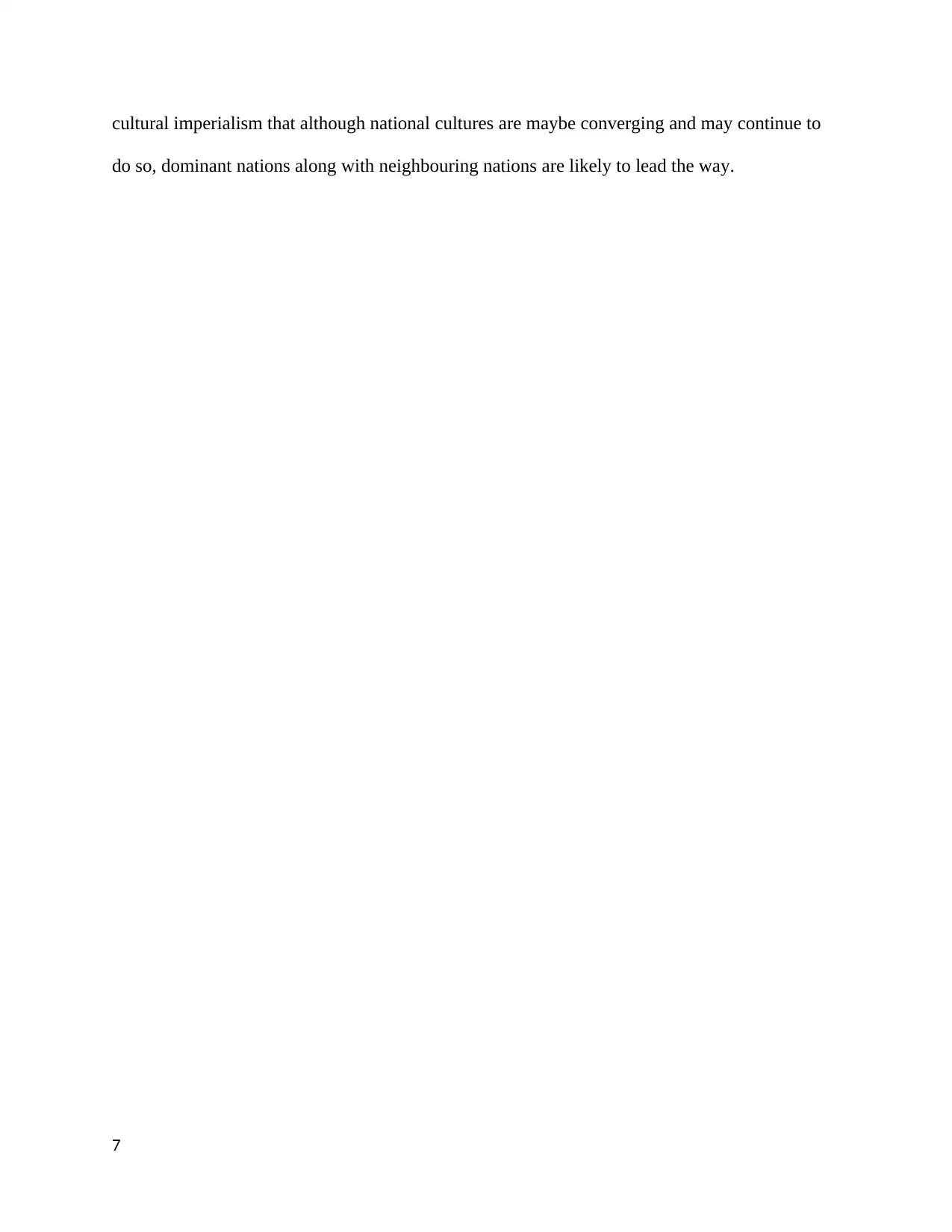
cultural imperialism that although national cultures are maybe converging and may continue to
do so, dominant nations along with neighbouring nations are likely to lead the way.
7
do so, dominant nations along with neighbouring nations are likely to lead the way.
7
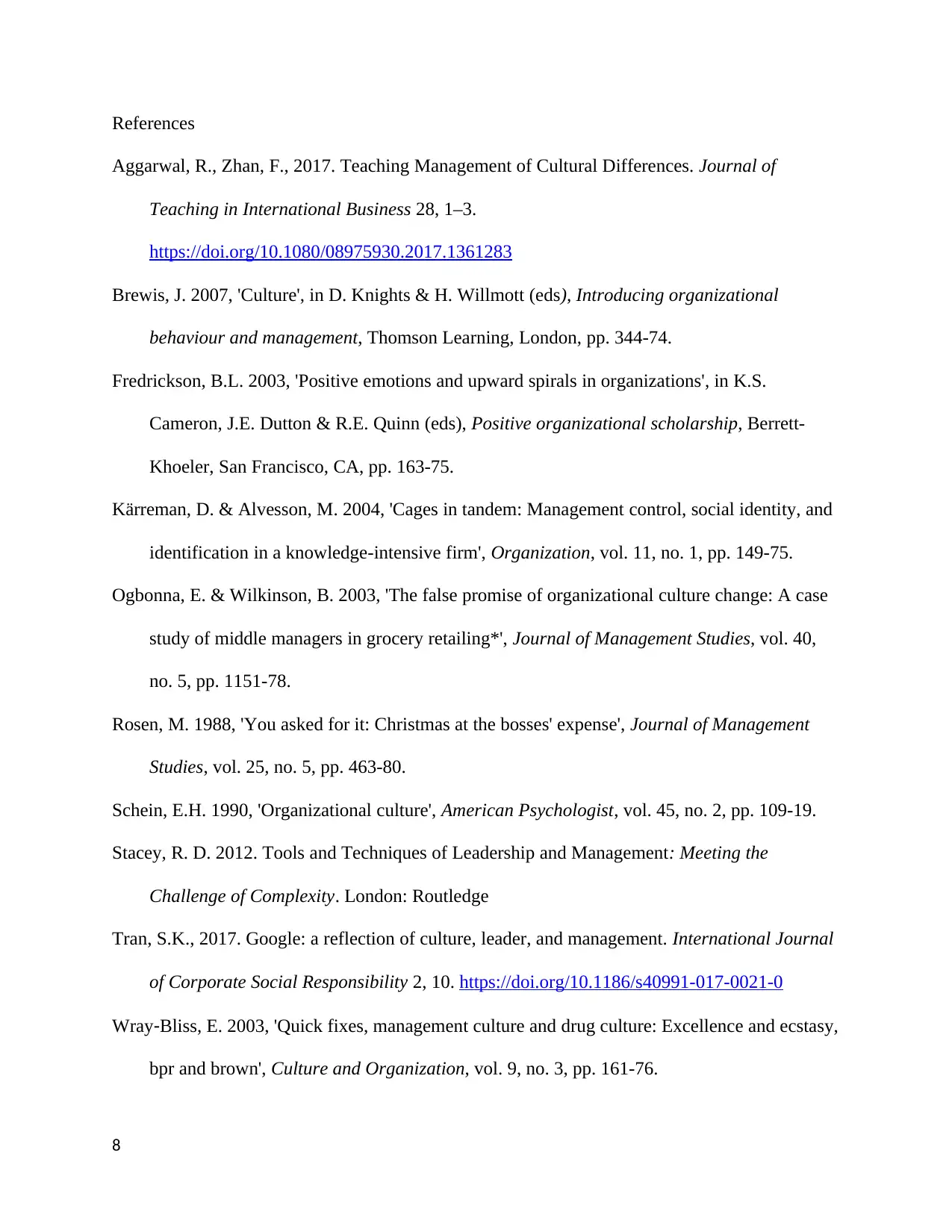
References
Aggarwal, R., Zhan, F., 2017. Teaching Management of Cultural Differences. Journal of
Teaching in International Business 28, 1–3.
https://doi.org/10.1080/08975930.2017.1361283
Brewis, J. 2007, 'Culture', in D. Knights & H. Willmott (eds), Introducing organizational
behaviour and management, Thomson Learning, London, pp. 344-74.
Fredrickson, B.L. 2003, 'Positive emotions and upward spirals in organizations', in K.S.
Cameron, J.E. Dutton & R.E. Quinn (eds), Positive organizational scholarship, Berrett-
Khoeler, San Francisco, CA, pp. 163-75.
Kärreman, D. & Alvesson, M. 2004, 'Cages in tandem: Management control, social identity, and
identification in a knowledge-intensive firm', Organization, vol. 11, no. 1, pp. 149-75.
Ogbonna, E. & Wilkinson, B. 2003, 'The false promise of organizational culture change: A case
study of middle managers in grocery retailing*', Journal of Management Studies, vol. 40,
no. 5, pp. 1151-78.
Rosen, M. 1988, 'You asked for it: Christmas at the bosses' expense', Journal of Management
Studies, vol. 25, no. 5, pp. 463-80.
Schein, E.H. 1990, 'Organizational culture', American Psychologist, vol. 45, no. 2, pp. 109-19.
Stacey, R. D. 2012. Tools and Techniques of Leadership and Management: Meeting the
Challenge of Complexity. London: Routledge
Tran, S.K., 2017. Google: a reflection of culture, leader, and management. International Journal
of Corporate Social Responsibility 2, 10. https://doi.org/10.1186/s40991-017-0021-0
Wray‐Bliss, E. 2003, 'Quick fixes, management culture and drug culture: Excellence and ecstasy,
bpr and brown', Culture and Organization, vol. 9, no. 3, pp. 161-76.
8
Aggarwal, R., Zhan, F., 2017. Teaching Management of Cultural Differences. Journal of
Teaching in International Business 28, 1–3.
https://doi.org/10.1080/08975930.2017.1361283
Brewis, J. 2007, 'Culture', in D. Knights & H. Willmott (eds), Introducing organizational
behaviour and management, Thomson Learning, London, pp. 344-74.
Fredrickson, B.L. 2003, 'Positive emotions and upward spirals in organizations', in K.S.
Cameron, J.E. Dutton & R.E. Quinn (eds), Positive organizational scholarship, Berrett-
Khoeler, San Francisco, CA, pp. 163-75.
Kärreman, D. & Alvesson, M. 2004, 'Cages in tandem: Management control, social identity, and
identification in a knowledge-intensive firm', Organization, vol. 11, no. 1, pp. 149-75.
Ogbonna, E. & Wilkinson, B. 2003, 'The false promise of organizational culture change: A case
study of middle managers in grocery retailing*', Journal of Management Studies, vol. 40,
no. 5, pp. 1151-78.
Rosen, M. 1988, 'You asked for it: Christmas at the bosses' expense', Journal of Management
Studies, vol. 25, no. 5, pp. 463-80.
Schein, E.H. 1990, 'Organizational culture', American Psychologist, vol. 45, no. 2, pp. 109-19.
Stacey, R. D. 2012. Tools and Techniques of Leadership and Management: Meeting the
Challenge of Complexity. London: Routledge
Tran, S.K., 2017. Google: a reflection of culture, leader, and management. International Journal
of Corporate Social Responsibility 2, 10. https://doi.org/10.1186/s40991-017-0021-0
Wray‐Bliss, E. 2003, 'Quick fixes, management culture and drug culture: Excellence and ecstasy,
bpr and brown', Culture and Organization, vol. 9, no. 3, pp. 161-76.
8
⊘ This is a preview!⊘
Do you want full access?
Subscribe today to unlock all pages.

Trusted by 1+ million students worldwide
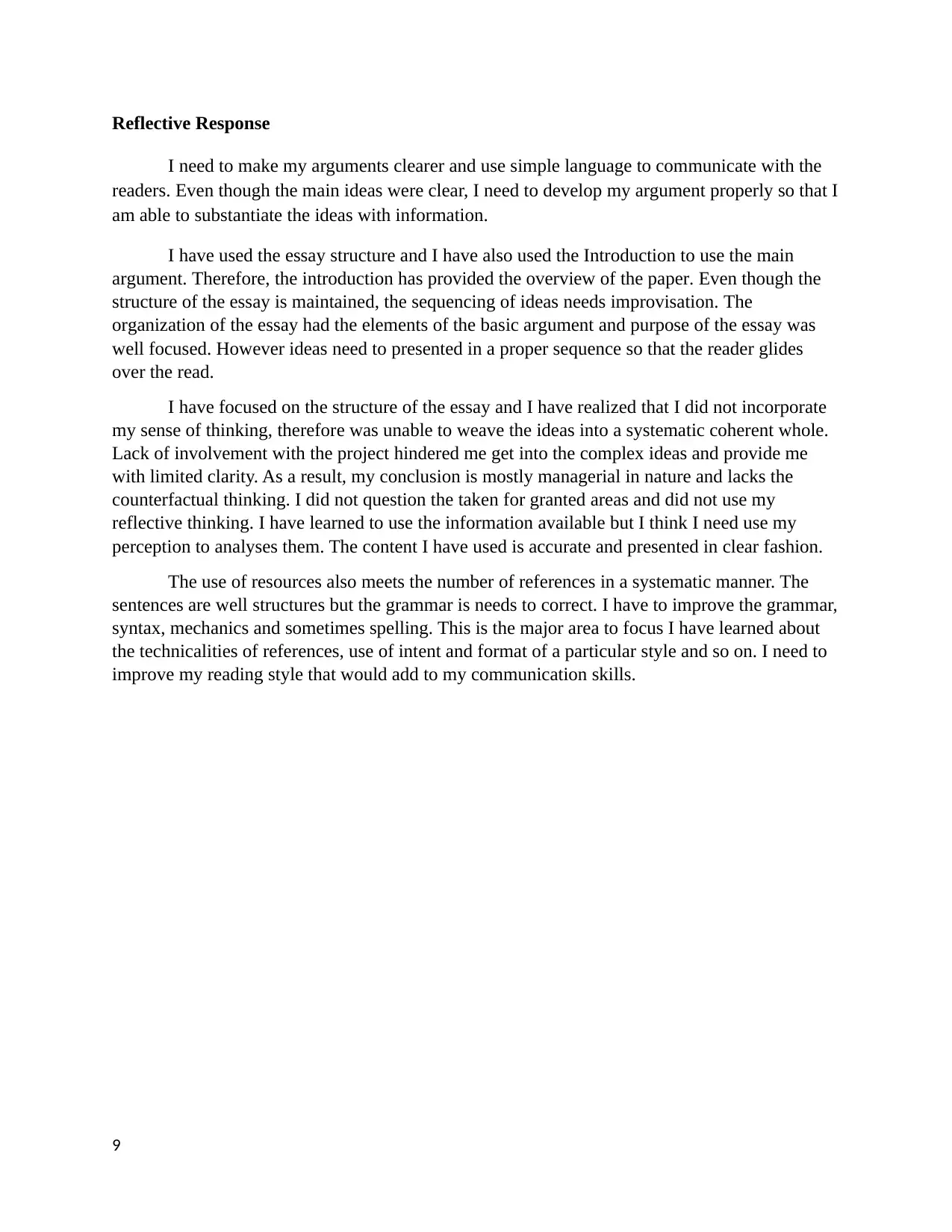
Reflective Response
I need to make my arguments clearer and use simple language to communicate with the
readers. Even though the main ideas were clear, I need to develop my argument properly so that I
am able to substantiate the ideas with information.
I have used the essay structure and I have also used the Introduction to use the main
argument. Therefore, the introduction has provided the overview of the paper. Even though the
structure of the essay is maintained, the sequencing of ideas needs improvisation. The
organization of the essay had the elements of the basic argument and purpose of the essay was
well focused. However ideas need to presented in a proper sequence so that the reader glides
over the read.
I have focused on the structure of the essay and I have realized that I did not incorporate
my sense of thinking, therefore was unable to weave the ideas into a systematic coherent whole.
Lack of involvement with the project hindered me get into the complex ideas and provide me
with limited clarity. As a result, my conclusion is mostly managerial in nature and lacks the
counterfactual thinking. I did not question the taken for granted areas and did not use my
reflective thinking. I have learned to use the information available but I think I need use my
perception to analyses them. The content I have used is accurate and presented in clear fashion.
The use of resources also meets the number of references in a systematic manner. The
sentences are well structures but the grammar is needs to correct. I have to improve the grammar,
syntax, mechanics and sometimes spelling. This is the major area to focus I have learned about
the technicalities of references, use of intent and format of a particular style and so on. I need to
improve my reading style that would add to my communication skills.
9
I need to make my arguments clearer and use simple language to communicate with the
readers. Even though the main ideas were clear, I need to develop my argument properly so that I
am able to substantiate the ideas with information.
I have used the essay structure and I have also used the Introduction to use the main
argument. Therefore, the introduction has provided the overview of the paper. Even though the
structure of the essay is maintained, the sequencing of ideas needs improvisation. The
organization of the essay had the elements of the basic argument and purpose of the essay was
well focused. However ideas need to presented in a proper sequence so that the reader glides
over the read.
I have focused on the structure of the essay and I have realized that I did not incorporate
my sense of thinking, therefore was unable to weave the ideas into a systematic coherent whole.
Lack of involvement with the project hindered me get into the complex ideas and provide me
with limited clarity. As a result, my conclusion is mostly managerial in nature and lacks the
counterfactual thinking. I did not question the taken for granted areas and did not use my
reflective thinking. I have learned to use the information available but I think I need use my
perception to analyses them. The content I have used is accurate and presented in clear fashion.
The use of resources also meets the number of references in a systematic manner. The
sentences are well structures but the grammar is needs to correct. I have to improve the grammar,
syntax, mechanics and sometimes spelling. This is the major area to focus I have learned about
the technicalities of references, use of intent and format of a particular style and so on. I need to
improve my reading style that would add to my communication skills.
9
Paraphrase This Document
Need a fresh take? Get an instant paraphrase of this document with our AI Paraphraser
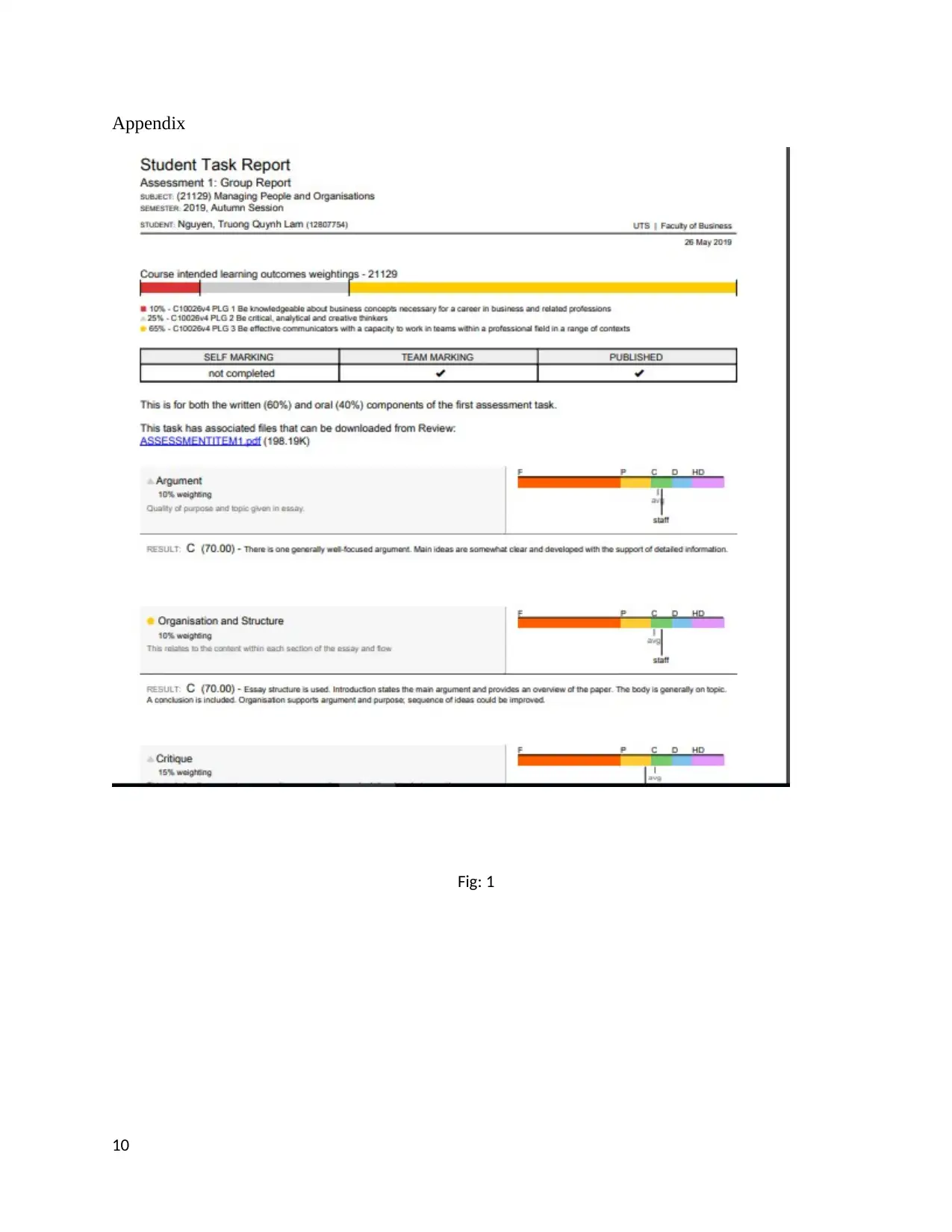
Appendix
Fig: 1
10
Fig: 1
10
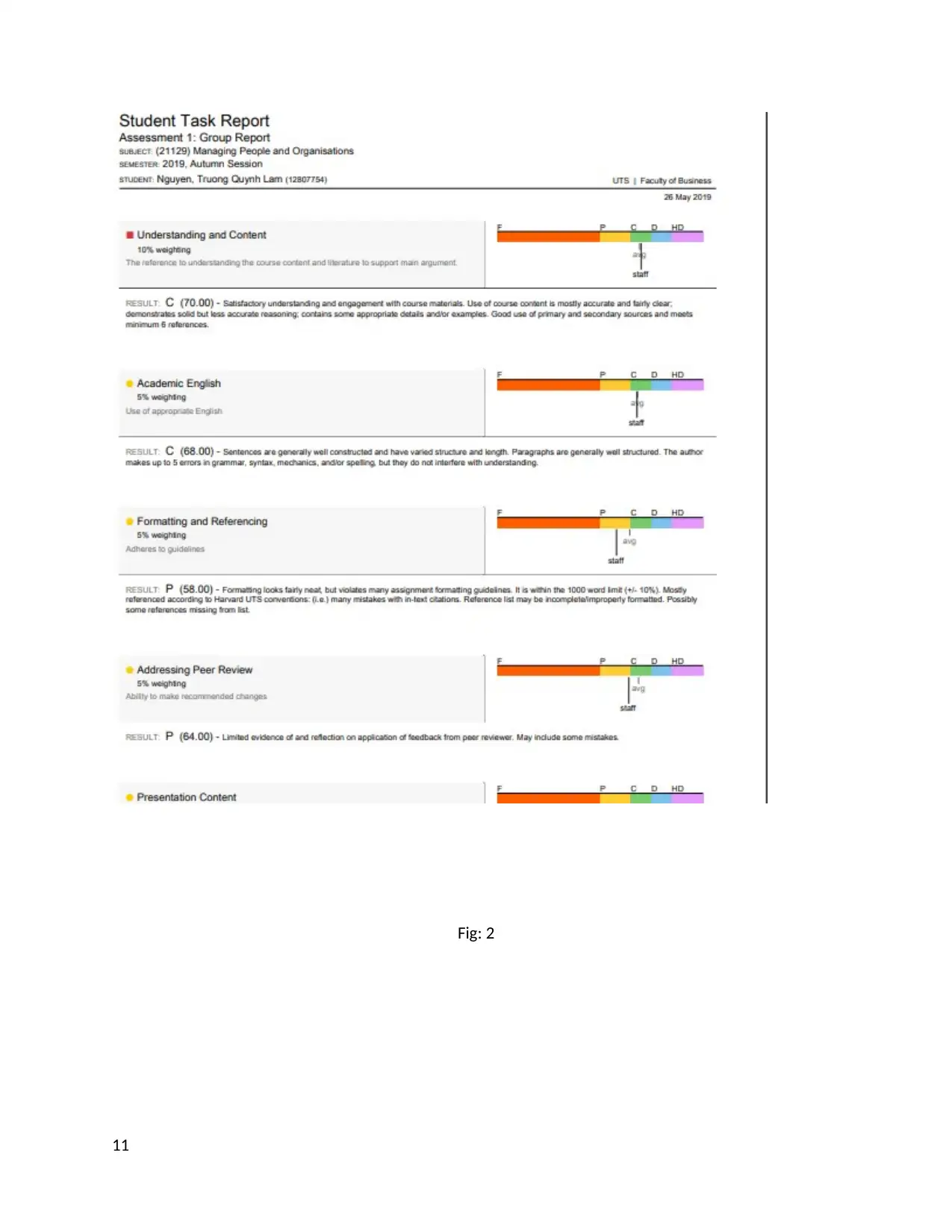
Fig: 2
11
11
⊘ This is a preview!⊘
Do you want full access?
Subscribe today to unlock all pages.

Trusted by 1+ million students worldwide
1 out of 13
Related Documents
Your All-in-One AI-Powered Toolkit for Academic Success.
+13062052269
info@desklib.com
Available 24*7 on WhatsApp / Email
![[object Object]](/_next/static/media/star-bottom.7253800d.svg)
Unlock your academic potential
Copyright © 2020–2025 A2Z Services. All Rights Reserved. Developed and managed by ZUCOL.





